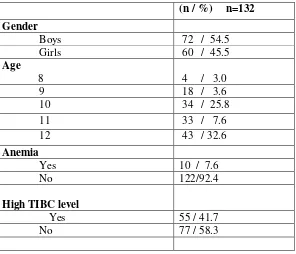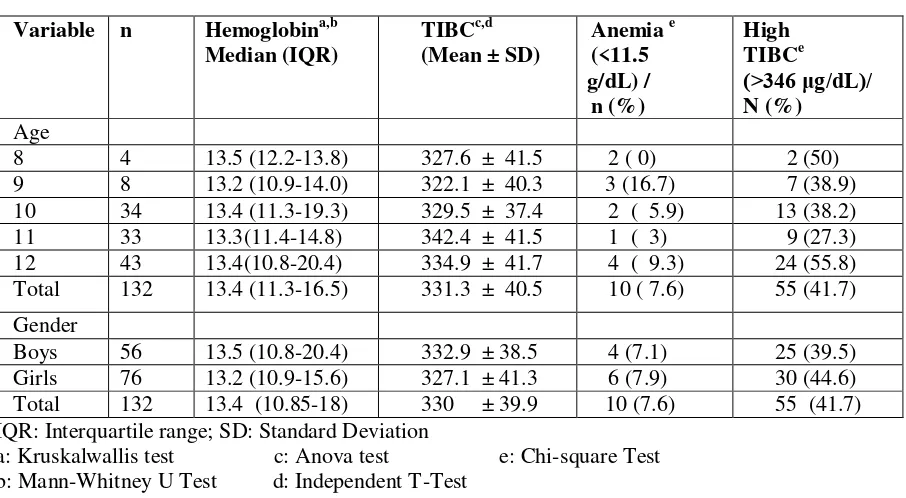Correlation of Anemia and Total Iron Binding Capacity
among Primary School Children in Medan
Zaimah Z Tala
1, Dewi Masyithah Darlan
2*, Cellya Amanta
3,
Syah Mirsya Warli
3,
Nurfida K Arrasyid
41
Nutrition Department, Faculty of Medicine, University of Sumatera Utara, Indonesia
2Parasitology Department, Faculty of Medicine, University of Sumatera Utara,
Indonesia
3
Medical Student, Faculty of Medicine, University of Sumatera Utara, Indonesia
4
Faculty of Medicine, University of Sumatera Utara, Indonesia
Abstract : Anemia is a condition in which the number of red blood cells or their oxygen carrying capacity is insufficient to meet physiologic needs. Iron Deficiency Anemia (IDA) is the most common type of anemia in society. Iron deficiency is the commonest form of malnutrition worldwide and according to the World Health Organization it affects 43%. We conducted a cross sectional study to examine the correlation of anemiaand TIBC among schoolchildren in Medan. A total of 132 children aged 9-12 years were studied. The mean level of hemoglobin and TIBC were 13.4 g/dL and 329.75μg/dL respectively. Data were collected using structured questionnaire, and laboratory analysis for blood samples. The prevalence of anemia was 7.6%, and high level of TIBC was 41.7%. The correlation between anemia and TIBC was 0.16 with P = 0.059. There was no correlation between anemia and TIBC. The risk of children with anemia for having High TIBC level was 1.78 times higher than children without anemia (RP 1.78 (CI: 1.121 – 2.823). More studies need to be done to find anemia cases and see its relation to TIBC.
Keyword : Anemia, TIBC, Primary School Children.
1. Introduction
Anemia is still an important public health problem worldwide with global prevalence estimated about 24.8%, and the majority of cases is in the developing countries, dominantly in Africa and South East Asia. Anemia has been classified by WHO as a severe public health problem (>40%) among children <5 years in 69 countries and in pregnant women in 68 countries [1]. Anemia is caused by various reasons such as nutritional deficiencies (Vitamin B12, iron, and folate), extra-corporal blood loss, Infectious diseases (HIV/AIDS, malaria, helminth infection, tuberculosis), chronic disease, socioeconomic factors and demographic factors [2].
The most common cause of anemia is Iron deficiency, about 20% - to 50% of the world’s population. It is common in young children and prevalence has been reported to be as high as 22% among East-Asian school children. Long term effect of anemia may cause the problem of emotional functioning, cognitive, immunity and physical in general [3]. A systematic analysis of global anemia estimated that, in East and Southeast Asia between 1995 and 2011, anemia decreased 25%, 21% and 25%, in children less than 5 years, non pregnant woman and pregnant woman, respectively [4]. However, there is no clear data about how many anemia cases that affected by Iron Deficiency Anemia (IDA) worldwide. According to the 2001 WHO data, 30% of the
International Journal of ChemTech Research
children aged between 0-4 years and 48% the children between 5 and 14 years are anemic in developing countries [5].
Prevalence of anemia in Indonesia steadily declined among Indonesian children, adolescents, women and men which assessed in the Indonesian Family Life Surveys (IFLS). Nevertheless this progress, anemia cases still remains a moderate public health problem in children < 12 years and in non-pregnant and pregnant women > 15 years; with the prevalence ranged from 20 – 39.9% [6].
Based on the study above, we conducted a research on the correlation between anemia and high TIBC level among Primary School Children. The main goal is to know the correlation between anemia and high TIBC level in the students of Primary School in Medan.
2. Methods and Data Analysis
A community based cross-sectional study was undertaken to evaluate the correlation of anemia and high TIBC level among Public Primary school children in, Amplas Medan and Hamparan Perak, Deli Serdang (Figure1). Children included in the study were enrolled in Primary school between May – October 2016. Samples were selected through consecutive sampling following inclusion and exclusion criteria. A total 132 subjects were included in this study. The inclusion criterias were all the students of grade 3, 4, 5, and 6 in Public Primary School 060925 Harjosari, Amplas, Medan and Public Primary School 101747 KlumpangKebun, Hamparan Perak, Deli Serdang which approved by the parents to be a participant in the study through informed consent.Exclusion criterias wereNo history of thalassemia, hemophilia, or anemia besides IDA, and have not undertaken any antihelminthic drugs for the last 6 months. Samples were excluded if the stool specimens or blood samples broken.
The study protocol was approved and granted by the Ethics Committee of the Faculty Medicine of University Sumatera Utara. Informed consent was taken before enrolling the children into the study. The procedure was fully explained to the parents and consent received before the procedures done. Permission was also taken from the primary school authority.
Figure 1. Study Area: SDN 101747 Hamparan Perak & SDN 060925 Amplas, Medan
determined when TIBC levels are > 346 μg/dL[2].
Statistical analysis of the data was performed using Predictive Analytics Software (PASW) for Mac version 20. For descriptive analysis, prevalence of anemia and high TIBC was expressed in percentage. The distribution of hemoglobin level was not normal and presented as median after being tested for normality using Kolmogrov-Smirnov Z test, meanwhile the distribution of TIBC was as normal distribution and presented as mean and standard deviation. Kruskallwallis, Mann-Whitney U, Annovadan T-Test were tested for differences in medians and means among groups.Fisher Exact test was used to investigate the association between dependent variables of high TIBC and independent variables of anemia. For each categorical variable, ratio prevalence (RP) and 95% confidence intervals (CI) were calculated using Fisher Exact test. The test was considered significant at P < 0.05. The correlation between anemia and TIBC level was computed using Contingency coefficient (r) test.
3. Results and Discussion
A total of 132 children (72 boys and 60 girls) were enrolled in this study. There were a total of 56 (52.4%) school children aged 8 to 10 years and 76 (57.6%) school children aged 11-12 years with median age of 11 to 12 years. The present study showed that 7.6% (10/132) of the participants had anemia, and 41.7% (55/132) had high TIBC level (Table 1).
Table 1. General characteristics of children participated in the study
(n / %) n=132 Gender
Boys 72 / 54.5
Girls 60 / 45.5
Age
8 4 / 3.0
9 18 / 3.6
10 34 / 25.8
11 33 / 7.6
12 43 / 32.6
Anemia
Yes 10 / 7.6
No 122/92.4
High TIBC level
Yes 55 / 41.7
No 77 / 58.3
Levels of serum TIBC, Hemoglobin, prevalence of anemia among school children according to age and gender are presented in table 2. The median of hemoglobin level according to age and gender were 13.4 g/dL (IQR= 11.3–16.5) and 13.4 g/dL (IQR=10.85-18), respectively. There was no significant difference in median hemoglobin level between age groups, χ2 = 3.47, P = 0.48. Similarly, we found no significant difference in median hemoglobin level between boys and girls, U = 2039.5, P = 0.58.Meanwhile the mean of TIBC according to age and gender was 331.3 μg/dL (SD = 40.5) and 330 μg/dL (SD 39.9), respectively. There was no significant difference in mean TIBC level between age groups, F = 0.366, P = 0.83. Similarly, no significant difference in mean TIBC level between boys and girls, t = -0.843. P = 0.4. The prevalence of anemia was 7.6%, there was no significant difference between age groups, χ2 = 3.47, P = 0.48. Also we found no significant difference between boys and girls, U = 2113, P =0.95. Likewise, the prevalence of high TIBC level was 41.7%, but there was no significant difference between age groups, χ2 = 0.35, P = 0.59, similarly between boys and
Table 2. Levels of serum TIBC, Hemoglobin, prevalence anemia among school children according to age
Table 3 shows the prevalence of High TIBC level was higher among children ≤10years compared with > 10 years (39.3% vs43.4%; RP: 0.905; 95% CI: 0.598-1.370) and the High TIBC level was higheramong girls compared to boys (39.5% vs 44.6% ; RP: 0.884 ; CI: 0.591– 1.323). There was no significant association between High TIBC level according to age and gender (P> 0.05). However, the prevalence of High TIBC level was higher among children with anemia compared to children without anemia (70% vs 39.3%; RP: 1.78; CI: 1.12-2.82). Meanwhile, anemia was a risk factor for elevated levels of TIBC, whereas age and sex was not a risk factor. All the three variables were a weak correlation with High TIBC level.
Table 3.Univariate analysis of factors associated with High TIBC level among Primary School Children in Medan (n = 132) a: Chi-Square test ; b: Contingency coefficient test
To compare our findings with other studies, the result showed that anemia among children in Yemen was higher (48.7%) compared to their counterparts Saudi Arabia was 17%. This high anemia could be association to poverty that resulted in insufficient nutrition and inadequate health care. The prevalence of anemia among children in other countries varied from as high as 60% in Somalia to as low as 14% in United Arab Emirates [9]. Similarly, Study in Zanzibar reported higher prevalence of anemia among preschool children (92%) and among pregnant women (78%) in Liberia, wherein more than 80% of the anemic cases where credited to Iron Deficiency Anemia (IDA) [12]. Iron Deficency Anemia was more common and severe influence if occurrence in children. This is caused by demands for growth increased. Other study in Malaysia reported the prevalence of IDA was 88.0% [12] and from Yemen reported the findings showed the prevalence of IDA was 34.2% [1].
The major categories that result in IDA aredecreased iron intake, increased iron utilization, Excessive loss of iron (physiological or pathological iron deficiency), Faulty or incomplete iron absorption (physiological iron deficiency) such as gastric resection; or chronic diarrhea, and pathological iron loss in adult males and postmenopausal females with iron deficiency. The hematological parameters for IDA are Serum Iron, Ferritin, TIBC, and transferrin saturation [13].
Generally, girls are common to be anemic than boys especially in the reproductive age due to physiological alterations. In the worldwide, the prevalence of the girls with productive age were 50% [14]. We found the concentration of hemoglobin elevated in girls (7.9% vs 7.1%), although no significant difference in median hemoglobin level between boys and girls. However other study in Malaysia, they found a significant difference in hemoglobin level according to gender, and the level of hemoglobin in girls was higher than boys (61.6% vs 34.1%) [1].
In the recent study showed the relation between Anemia with High TIBC level werenot significant, however the risk (Ratio Prevalence) was 1.78 (CI: 1.121-2.823). This result showed the children with anemia have risk for having High TIBC level. The mean value of TIBC was 329.75 μg/dL. The previous study among 490 children in hospital, the mean value of TIBC was higher than our study (404 μg/dL) [1]. The level of TIBC was examined in this study, however the association both the results were no significantly according to age and gender. Moreover, this result was similar to other study in Malaysia, no significant difference in the levels of TIBC between boys and girls [12].
The limitation of this study is not enough case for anemia and the minimal sample not achieved. TIBC is commonly raised when total body iron stores are low, a possible indication of iron deficiency anemia. In the present study, we found a few cases anemia than previous study.
4. Conclusion
Our findings provide a population-based picture of hemoglobin and high TIBC level among school children. There was no statistically significant difference of level hemoglobin according to age groups and gender. Likewise, the result showed no statistically significant difference of level TIBC according to age groups and gender. The prevalence of anemia and high TIBC level among school children was low. About 7.6% of the children were anemia and high TIBC of the children were 41.7%. The prevalence of anemia and high TIBC was not significant according to age and gender. Similarly, there was no correlation between anemia with TIBC. The children with anemia were risk for having high TIBC level 1.78 times than the children without anemia.
Acknowledgments
The authors gratefully acknowledge that the present research is supported by Ministry of Research and Technology and Higher Education Republic of Indonesia. The support is under the research grant BP-PTN USU of Year 2016.
References
among Children in Yemen. American Journal of Health Research 2014; 2(5): pp. 319-326. doi: 10.11648/j.ajhr.20140205.26
2. WHO. Hemoglobin concentrations for the diagnosis of anemia and assessment of severity. Vitamin and mineral nutrition information system. Geneva: World Health Organization; 2011
3. Abdulsalam M, Daniel A. Diagnosis, pengobatan dan pencegahan anemia defisiensi besi. Sari Pediatri 2002; 4 (2) September: 74-77
4. Stevens GA, Finucane MM, De-Regil LM, Paciorek CJ, Flaxman SR, Branca F, Peña-Rosas JP, Bhutta ZA, Ezzati M. Global, regional, and national trends in haemoglobin concentration and prevalence of total and severe anaemia in children and pregnant and non-pregnant women for 1995- 2011: a systematic analysis of population-representative data. Lancet Glob Health 2013;1:e16-25. DOI: 10.1016/S221 4-109X(13)70001-9.
5. World Health Organization. Iron deficiency anemia assessment, prevention, and control. A guide for programme managers. Geneva (Switzerland): World Health Organization; 2001.
6. Barkley JS, Kendrick KL, Codling K, Muslimatun S, Pachom H. Anemia prevalence over time in Indonesia: estimates from the 1997, 2000, and 2008 Indonesia family Life surveys. Asia Pac J Clin Nutr 2015; 24(3):452-455
7. World Health Organization.Worldwide prevalence of anaemia 1993-2015. Spain: World Health Organization; 2008.
8. Özdemir N. Iron deficiency anemia from diagnosis to treatment in children. TürkPedArş [Internet]. 2015 Jan [cited 2016 Jun 17]; 50: 11-9.
9. Abu Syed Mohammed Mujib, Abu Sayeed Mohammad Mahmud, Milton Halder, and Chowdhury Mohammad Monirul Hasan, “Study of Hematological Parameters in Children Suffering from Iron Deficiency Anaemia in Chattagram Maa-o-Shishu General Hospital, Chittagong, Bangladesh,” Anemia, vol. 2014, Article ID 503981, 10 pages, 2014. doi:10.1155/2014/503981
10. Dewi Masyithah Darlan, Ferry FV Kaban. Correlation between Soil Transmitted Helminth Infection and Incidence of Anemia at Public Primary School 060925. International Journal of PharmTech Research, 2016, 9(6), pp 185-190.
11. Bagchi, K. Irondeficiencyanemia-anoldenemy. East Mediterr Health J (2004); 10: 754-760.
12. Aini Nor U, Hesham MS, Azlin M. et al. Serum Iron status in Orang Asli Children living in endemic areas of soil transmitted helminths. Asia Pac J Clin Nutr. (2007); 16(4): 724-730
13. Mary L. Turgeon. Iron Deficiency Anemia and Anemia of Chronic Inflammation. In Clinical Hematology; Theory and Procedures 5th Ed. Lippincott Williams & Wilkins; 2012: 166-180.
14. WHO. The prevalence of anemia in women, A tabulation of available information. WHO/MCH/MSM/92.World Health Organization.


